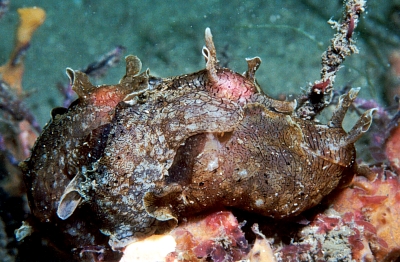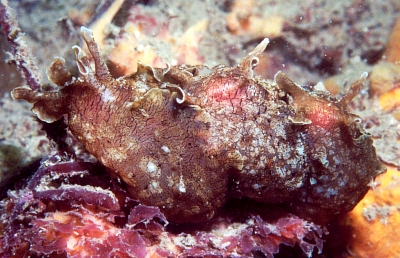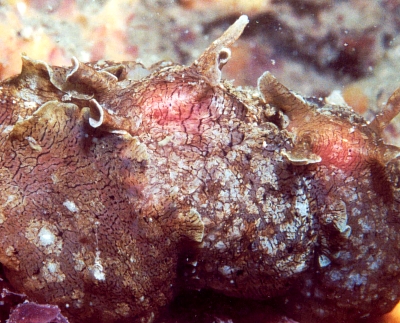Aplysia sydneyensis - chain mating
January 31, 2007
From: Leanne & David Atkinson


Dear Bill,
Re: message 19115 from Tess
Here are left and right side photos we took of Sea Hares mating at The Pipeline which is only a few kilometres east of Corlette in Port Stephens.For non divers it is between Dutchies Beach and the western side of D'Albora Marina Nelson Bay.
Since they're mating we'd assume they are adults? These were relatively small in comparison to the ones we see commonly in Port Stephens which we assume are Aplysia extraordinaria.We wondered whether these were Aplysia juliana or Aplysia extraordinaria. Our attentions flashing away with cameras didn't disturb them and consequently we don't know what colour ink they produce. Can you identify them for us please Bill?
Locality: The Pipeline, Nelson Bay, Port Stephens, 8 metres, New South Wales, Australia , Pacific, 06 November 2005, Sandy silty bottom scattered sponges, algae, ascidians and soft corals. Length: approximately 90 mm. Photographer: Leanne & David Atkinson.
Regards,
Leanne & David Atkinson
atk@hunterlink.net.au
Atkinson, L. & D., 2007 (Jan 31) Aplysia sydneyensis - chain mating. [Message in] Sea Slug Forum. Australian Museum, Sydney. Available from http://www.seaslugforum.net/find/19204
Dear Leanne & David,
Sea hares and cephalaspidean 'bubble shells' often mate in chains like this [see Fact Sheet]. As you guessed, this is not A. extraordinaria, but the smaller, non-swimming, Aplysia sydneyensis. Apart from size, A. extraordinaria has much larger parapodia, in proportion to the rest of the body. The three animals in your chain well illustrate colour variation in the species. In general there is a translucent brownish background colour with a pattern of brown reticulate lines and white patches. In the close-up alongside, the colour of the animal on the left is dominated by the brown reticulation, and in the animal on the right the white patches dominate. However in the animal in the middle has both white patches and reticulate pattern.
The reddish-pink patch on the head of each animal, is caused by the bright red buccal bulb showing through the body wall. The buccal bulb is the highly muscular organ that contains the jaws and radular teeth.
Best wishes,
Bill Rudman
Related messages
-
Aplysia sydneyensis from eastern Australia
From: Sascha Schulz, September 14, 2005 -
Aplysia sydneyensis from eastern Australia
From: Francis Hawkshaw, August 5, 2005 -
Colour form? of Aplysia juliana
From: Paul Furneaux, November 12, 2003 -
Aplysia sydneyensis
From: Joan Hales, November 29, 2002
